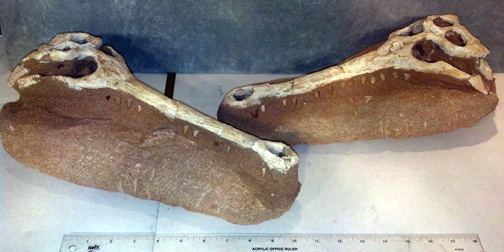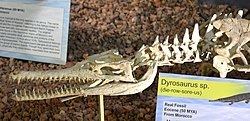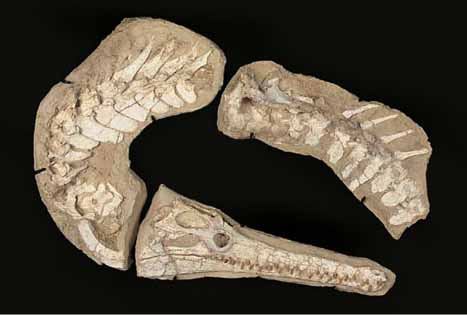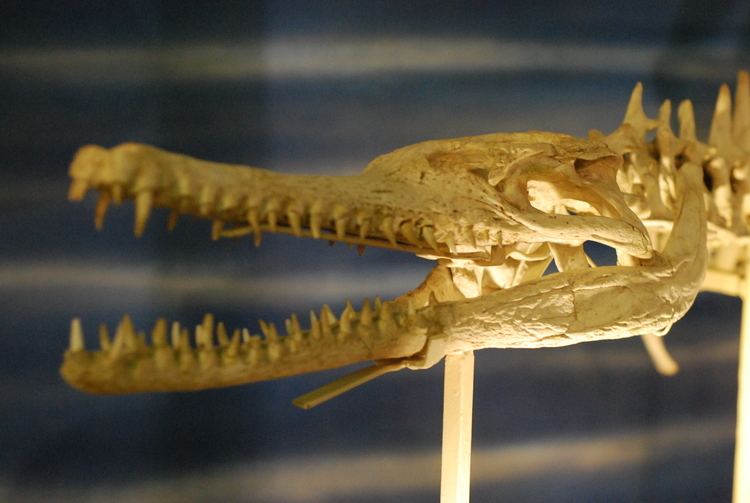Rank Genus | Class Reptilia Phylum Chordata | |
 | ||
Similar Dyrosauridae, Rhabdognathus, Chenanisuchus, Arambourgisuchus, Terminonaris | ||
Dyrosaurus is a genus of extinct crocodylomorph that lived from the upper Cretaceous to the Eocene period, surviving the K-Pg extinction event. Dyrosaurus are linked to pholidosaurids as a clade are defined as slender-snouted, fish-eating specialists adapted to near-shore marine habitats.
Contents

The Dyrosauridae are a group of mostly marine, long jawed, crocodile-like animals up to 6 meters long. Based on bone tissue evidence, it has been hypothesized that the they were slow-growing near-shore marine animal that had interlocking closed jaws and were quadrupedal with the ability to swim as well as walk on land. It has external nostrils at the posterior end of its snout and an internal naris in its pterygoid, indicative of the need for hunting while swimming with its top of its skull protruding from the water to breathe and see prey easily.

Fossils from this genus have been found in Africa, Europe, North and South America, Southern Asia and India. Although the family Dyrosauridae is quite diverse with many forms of crocodyliforms, the genus Dyrosaurus has only two described species: D. phosphaticus and D. maghribensis. D. phosphaticus was first discovered in Algeria and Tunsinia whereas D. maghribensis has only been found in Morocco. D. maghribensis differs from D. phosphaticus by several synapomorphies, most notably: a smooth dorsal margin of the parietal and widely opened choanae, interfenestral bar wide and strongly T shaped instead of moderately T shaped.

Description

Dyrosaurids are known to have a very characteristic skull shape with a long and thin snout that is approximately 68% of the total skull length. The most anterior part of the skull and snout is the external naris followed posteriorly by two premaxillae bones until they reach two maxillae bones separated by a single nasal bone.

Typical in dyrosaurids is a single nasal element with a characteristic collection of small pits and a constant width until it widens to contact the lacrimal bones, then tapering off for a short distance until it meets the boundary of the frontals and prefrontals.
Dyrosaurs have a premaxilla with shallow pits that extend posterior to the third maxillary alveoli. There are two premaxillae that are narrow as compared to the maxillary bones and extend in the two long maxilla bones which separated by the single nasal bone. The last premaxilla and first maxilla are widely separated by a fourth dentary tooth. Alveoli are widely spaced anteriorly and the space between them decreases posteriorly from the fifteenth alveolus with the diameter remaining constant.
The maxilla is long (approx. two and a half times the length of jugal) and forms most of the lateral margin of the skull. According to Jouve and Barbosa and perhaps depending on the age of the animal, each maxilla bears 13-19 teeth.
An important feature of the dyrosaurid dentition are deep occlusal pits, present particularly in the posterior region of the maxillae that get less pronounced anteriorly. The pits are indicative of an interlocking closed jaw for dyrosaurids because the pits give a way for the upper and lower jaws to alternate. Although they are still present in dyrosaurus phosphaticus, this feature of deep occlusal pits become less developed and broad. Dyrosaurus teeth are homodont, conical, long, and slender, with asymmetrically labial and lingual surfaces. Posterior teeth are shorter and more compressed than anterior tooth indicating that the tooth size decreased anterior to posterior.
Dyrosaurs have a snout to skull length of about 68% and the genus Rhabdognathus and Atlantosuchus, Dyrosaurus and Arambourgisuchus have the largest snout proportions of all dyrosaurids. Snout length was previously used it to establish dyrosaurid relationships, while considering the lengthening of the snout to be a ‘more evolved’ character. This was not congruent with Jouve's conclusion which was that the longest snout is actually the primitive condition so the shorter or longer snout appears independently at least four times in dyrosaurid evolution.
While both are species in the Dyrosaurus clade, D. maghribensis and D. phosphaticus have some difference, one of them being the shape and style of their osteoderm. D. maghribensis have lateral and medial dorsal osteoderms that are not sutured and have no serration.The anterolateral margin of medial row of the dorsal osteoderms have a rounded lateral lobe and the lateral row of dorsal osteoderms are square in shape with rounded corners. D. phosphaticus has four longitudinal rows of square osteoderms that are thin and have shallow and wide pits. The osteoderms are square and the anterolateral margin of the medial dorsal osteoderms have an acute rounded process directed laterally.
History of discovery
French paleontologist Auguste Pomel named the genus Dyrosaurus in 1894 for Djebel Dyr, a mountain near Tebessa in Algeria where its fossilized vertebrae were found in a phosphate mine. Thévenin (1911a, 1911b), with some better preserved material, was the first to confirm indisputably that Dyrosaurus phosphaticus was a Lower Eocene crocodyliform. Many dyrosaurid remains are known, but unfortunately they are often poorly preserved which makes it difficult for paleontologists to get a strong understanding of the family.
The genus Dyrosaurus was created by A. Pomel (1894a) after M. Philippe Thomas discovered teeth and bone fragments from the Lower Eocene of Tunisia as Crocodilus Phosphaticus. In 1903, the family Dyrosauridae was named by Giuseppe de Stefano referring to the locality for the holotype was found in Djebel Dyr, Algeria. Stephanie Jouve found and published her results on the study of Dyrosaurus maghiribensis a species of the genus Dyrosaurus in 2005.
Paleobiology
Evidence for the semi-aquatic life of dyrosaurids comes from careful analysis of bone structure. There are two types of structural bone organization that can occur in aquatic tetrapods: osteoporotic or pachyostotic. Osteoporotic bone is spongy and porous whereas pachyostotic involves an increase in skeletal mass. Spongy/porous bone such as osteoporotic is associated with faster swimming and better maneuverability in water because of the reduction in bone tissue, many extant cetaceans and marine turtles have osteoporotic bone which enables them to be good swimmers. Pachyostotic bone is a general/local increase in skeletal mass which can be caused by osteosclerosis (inner compaction of bone), pachyostosis (hyperplasy of compact cortices) or pachyeosclerosis (combination of the two). Research on dyrosaur bone performed by Rafael César Lima Pedroso de Andrade, Juliana Manso Sayao revealed that this family had osteoporotic bone tissue indicative of a fast-swimming ecology as well as some osteosclerosis which is a component of pachyostotic bone tissue. Osteoporosis is associated with a fully aquatic lifestyle whereas pachyostotic is not fully aquatic but is associated with fast swimming ecology. Therefore dyrosaurs are semi-aquatic fast swimmers as indicated by their bone structure. Other evidence for near shore, semi-aquatic lifestyle is where the fossils are found, often in transitional marine sediments. -using axial frequency swimming (that used primarily by extant crocodylians) with a greater undulatory motion and frequency of the tail due to highly developed musculature allowing a more powerful forward thrust.
Dyrosaurids have a tissue pattern that is indicative of a slow-growth animal that was determined by careful analysis of a right femur and left tibia. In the left tibia, the cortex had a lamellar zonal bone with five lines of arrested growth (LAGs) which were spaced 300 mm apart, well as a clear vascular networks of primary osteons that decreased in density towards the membrane (periostially). The right femur had double LAGs and an EFS later as well as secondary osteons occurring in the deep cortex and the spongiosa. This tissue growth pattern is a common characteristic of slow growing animals.
Palaeoecology
Dyrosaurids are found in transitional marine sediments from the Late Cretaceous to Lower Eocene. This family is known mainly from Maastrichthian deposits in New Jersey and the late Cretaceous to early Paleogene rock from the Tethys Sea in northern and western Africa. Fossils have also been found from the Paleocene and Eocene strata of Pakistan, as well as South America, Brazil, India, Southern Asia as well as coastal. Generally dyrosaurids are recovered from coastal and estuarine deposits through North Africa and the Middle East confirming their existence as semi-aquatic animals. A newer specimen was found in the deposits of the Maria Farinha Formation, the Poty Quarry appears to be an important area because it contains the most complete exposed marine section of the Cretaceous-Paleogene transition in South America.
Dyrosauridae had its greatest taxonomic diversity during the Early Paleogene but it appears as though the clade was able to obtain a greater and more widespread geographic distribution during the Late Cretaceous. The earliest records of dyrosaurids are either in or close to Africa with fragmentary occurrences from the Cenomanian of Sudan and Portugal and several other pre-Maastrichtian, Late Cretaceous discoveries in Egypt. Later, by the Maastrichtian of North America, the record of dyrosaurids became more complete by establishing a widespread distribution that appears to be maintained through the Paleocene and Eocene.
Many similarly sized adults but very few juvenile dyrosaurids have been found in the Oulad Abdoun Basin and Lower Eocene beds. This is indicative of juvenile Dyrosaurids living in freshwater environments whereas large adults live in marine environments. Marine environments are known to have been highly affected by the K-T mass extinction whereas freshwater environments were less affected. Therefore, under the assumption the juveniles lived in freshwater environments and adults lived in marine environments juveniles were able to survive better and the genus could avoid total extinction.
